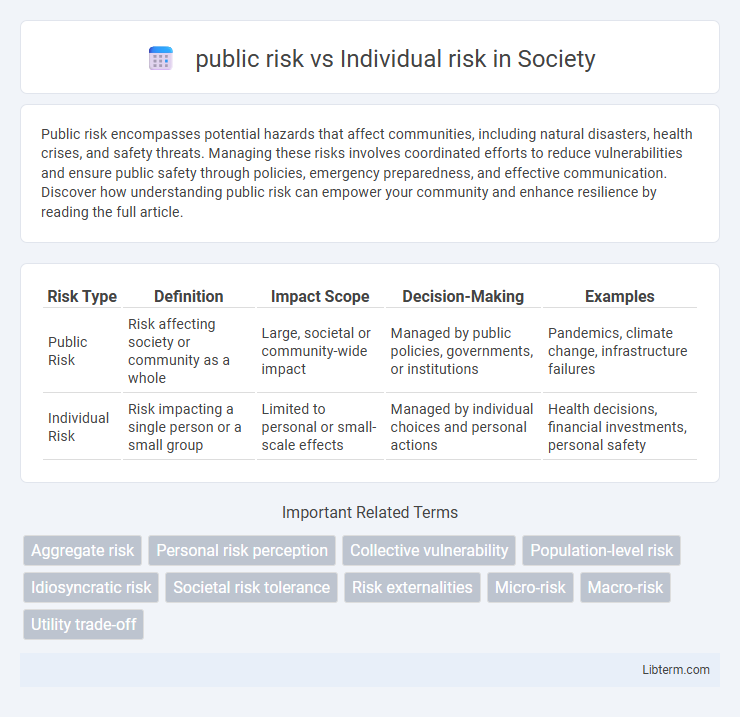Public risk encompasses potential hazards that affect communities, including natural disasters, health crises, and safety threats. Managing these risks involves coordinated efforts to reduce vulnerabilities and ensure public safety through policies, emergency preparedness, and effective communication. Discover how understanding public risk can empower your community and enhance resilience by reading the full article.
Table of Comparison
| Risk Type | Definition | Impact Scope | Decision-Making | Examples |
|---|---|---|---|---|
| Public Risk | Risk affecting society or community as a whole | Large, societal or community-wide impact | Managed by public policies, governments, or institutions | Pandemics, climate change, infrastructure failures |
| Individual Risk | Risk impacting a single person or a small group | Limited to personal or small-scale effects | Managed by individual choices and personal actions | Health decisions, financial investments, personal safety |
Defining Public Risk and Individual Risk
Public risk refers to the probability of harm or adverse effects impacting a large population or community due to environmental, health, or safety hazards. Individual risk is the likelihood of a specific person experiencing harm based on personal exposure, behavior, and susceptibility factors. Understanding the distinction between public risk and individual risk enables targeted risk management strategies and resource allocation in public health and safety sectors.
Key Differences Between Public and Individual Risk
Public risk refers to potential harm affecting a large group or community, whereas individual risk pertains to the likelihood of harm to a single person. Public risk assessment often involves evaluating widespread environmental, health, or safety hazards, while individual risk focuses on personal exposure and vulnerability factors. The key difference lies in the scope and scale of impact, with public risk addressing collective consequences and individual risk emphasizing personal probability of adverse outcomes.
Examples of Public Risks in Society
Public risks in society encompass natural disasters like hurricanes and earthquakes, widespread pandemics such as COVID-19, and large-scale technological failures including power grid outages. These risks affect entire communities or populations, leading to significant social, economic, and health impacts. Examples also include environmental hazards like air and water pollution, which pose collective threats to public health and safety.
Common Types of Individual Risk
Common types of individual risk include health-related issues such as chronic illnesses, accidents, and lifestyle diseases, which directly affect personal well-being. Financial risks like job loss, unexpected expenses, and inadequate savings impact an individual's economic stability. Psychological risks, including stress and mental health disorders, contribute significantly to overall individual vulnerability and resilience.
Risk Assessment: Public vs. Individual Perspectives
Risk assessment from a public perspective evaluates potential hazards affecting entire populations, incorporating statistical data on exposure, probability, and severity to guide regulatory policies. Individual risk assessment focuses on personal vulnerability, lifestyle factors, and specific exposure scenarios to estimate the likelihood of harm to a single person. Effective risk management requires balancing public health priorities with personalized risk information to optimize prevention and response strategies.
The Role of Government in Managing Public Risk
Government plays a critical role in managing public risk by implementing regulations, safety standards, and emergency response systems that protect the health and welfare of the population. Through public health policies, disaster preparedness programs, and risk communication strategies, authorities work to minimize widespread hazards that affect communities. Effective government intervention balances individual freedoms with collective safety, ensuring societal resilience against natural disasters, pandemics, and technological threats.
Personal Responsibility in Minimizing Individual Risk
Personal responsibility plays a crucial role in minimizing individual risk by encouraging proactive behaviors such as regular health checkups, adherence to safety protocols, and informed decision-making. Emphasizing personal accountability enhances risk awareness, reduces vulnerability to hazards, and promotes safer environments. Effective public health strategies often integrate individual actions to complement broader risk management frameworks, thereby improving overall community resilience.
Public Policy Approaches to Risk Mitigation
Public policy approaches to risk mitigation prioritize minimizing public risk through regulatory frameworks, safety standards, and widespread preventive measures that protect communities and ecosystems. Strategies often include risk assessment protocols, emergency preparedness planning, and investment in infrastructure resilience to reduce systemic vulnerabilities. Emphasizing collective safeguards ensures that individual risks are managed within a broader context of social equity and public health preservation.
Challenges in Balancing Public and Individual Interests
Balancing public risk with individual risk involves challenge in prioritizing collective safety while respecting personal freedoms and rights. Effective risk management requires transparent communication, ethical decision-making, and equitable resource allocation to address diverse societal needs. Conflicts often arise when public health measures limit individual autonomy, necessitating policies that consider both community welfare and personal choice.
Future Trends in Risk Management
Future trends in risk management emphasize integrating advanced analytics and AI to better quantify public risk and individual risk with higher precision. Emerging technologies enable dynamic risk assessment models that account for population-wide impacts alongside personalized risk profiles, enhancing decision-making capabilities. The growing focus on real-time data and predictive insights supports proactive risk mitigation strategies applicable at both public and individual levels.
public risk Infographic

 libterm.com
libterm.com